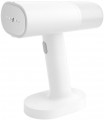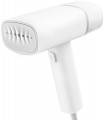In box
Additional accessories and equipment supplied with the device.
Modern steamers can be equipped with ironing accessories – irons and mini irons,
ironing boards,
vertical stops,
trouser clips,
telescopic stands and additional
bottom clips; accessories for processing fabrics –
brushes,
fabric nozzles, nozzles
for delicate fabrics,
for arrows; as well as some other items. Here is a more detailed description of the most common options:
–
Iron. A classic iron connected to a steamer with a hose. Such equipment actually turns the device into a
steam generator for ironing; and models equipped with an ironing board (see below) are often comparable in functionality with full-fledged
ironing systems.
–
Mini iron. Reduced analogue of a conventional iron. It is not designed for large volumes of ironing, but for simple tasks like ironing 1-2 items of clothing or refreshing a business suit, such a device is quite enough.
– Ironing board. The classic ironing board is a horizontal surface used for ironing fabrics. G
...arment steamers are equipped with small boards, which are usually installed vertically during non-working hours and, to some extent, can also replace vertical stops. Usually such a board is mounted on a telescopic stand.
– Vertical stop. Device in the form of a plane mounted vertically. In fact, it is an analogue of an ironing board used for vertical steaming: the processed fabric can be pressed against such a “board”, providing more intensive and efficient processing. Foldable ironing boards can perform a similar function, but they are not considered vertical stops, because they are small and have limited capabilities (whereas a full-fledged stop allows you to completely process trousers or other similar clothing in one session).
– Fabric nozzle. Microfiber nozzle – fabrics based on microscopic fibers. It is used for vertical steaming of various fabrics, thanks to which the steam is evenly distributed over the entire treated surface. Does not leave particles of pile on the surface.
– Nozzle for delicate fabrics. The specific design of such nozzles may be different, however, in any case, they provide the most gentle treatment, with a reduced intensity.
— Brush. In this case, brushes are meant for cleaning clothes and other fabric products. Thanks to the effect of steam, cleaning with this nozzle is more effective than with a manual clothes brush.
– Nozzle for arrows. Special nozzles for forming arrows on trousers. Such nozzles are usually clips of a special design. They are not as convenient to use as traditional irons and mini irons, and the use of such a device requires certain skills. On the other hand, this type of nozzle allows you to refresh the arrows even if there is no ironing board or vertical stop.
– Trouser clip. A special clip that allows to hang trousers and other similar products on the stand of the garment steamer. By default, hangers are installed in steamers, however, for some products they are poorly suited or not suitable at all; in light of this, clips of this type are often also provided in the design. Typically, such a clip is a pair of specific clothespins mounted on the crossbar of the coat hanger.
– Bottom clip. Clip mounted on the garment steamer at the bottom of the stand; usually, it is equipped with a movable mount and can be adjusted in height, it is also often made detachable. In most models, such a device is combined with a trouser clip and has the same design – in the form of a pair of clothespins; however, there are steamers that have only the bottom pair of clothespins – in addition to the usual hangers. In any case, such a clip allows to stretch the clothes hanging on the stand – this further contributes to the effectiveness of the steaming.
– Telescopic stand. A garment steamer stand with a telescopic design – which allows to adjust the height at which the clothes hanger is located. The convenience of this feature is obvious: it makes it possible to adjust the height of the hanger to the specifics of the situation and a particular product. At the same time, telescopic stands are relatively inexpensive, so that such equipment is almost mandatory for modern garment steamers (with the exception of portable handheld varieties).Water boiler volume
The volume of the water boiler used in the steamer.
First of all, we emphasize that you should not confuse the boiler and the water tank (see below). A boiler is a reservoir in which water is heated to form steam; in some models, such a reservoir is supplemented by a cold water tank, in others, the entire supply of water is located directly in the boiler. Accordingly, the meaning of this parameter depends on whether the device has an additional tank or not.
If there is a separate tank in the design, then the volume of the boiler is rather a secondary indicator: it is selected in such a way as to provide the claimed performance (and it is worth focus on these specifications when choosing). If there is no tank, then the volume of the boiler directly depends on how much water will fit in the device and how long it can work on one such refill. At the same time, an increase in volume allows to work longer without refueling, but it affects the dimensions, weight, price, and often also the power consumption of the device (a more capacious boiler requires a more powerful heater).
Water tank volume
The volume of the tank for the water supply provided in the device.
We emphasize that this indicator should not be confused with the volume of the boiler (see above): in this case, we are talking about a reservoir with a supply of cold water, from which such water enters the boiler for heating. Not every steam cleaner is equipped with such a reservoir.
Heating time
Heating time until steam is generated. The duration of the heating process directly depends on the power of the device and the volume of the water tank.
We also note that in some situations the actual heating time may be less than the declared one. For example, if the main tank (boiler) is not completely filled, and the design does not provide an additional tank for cold water. For a full guarantee, you should still focus on the value directly stated in the specifications.

